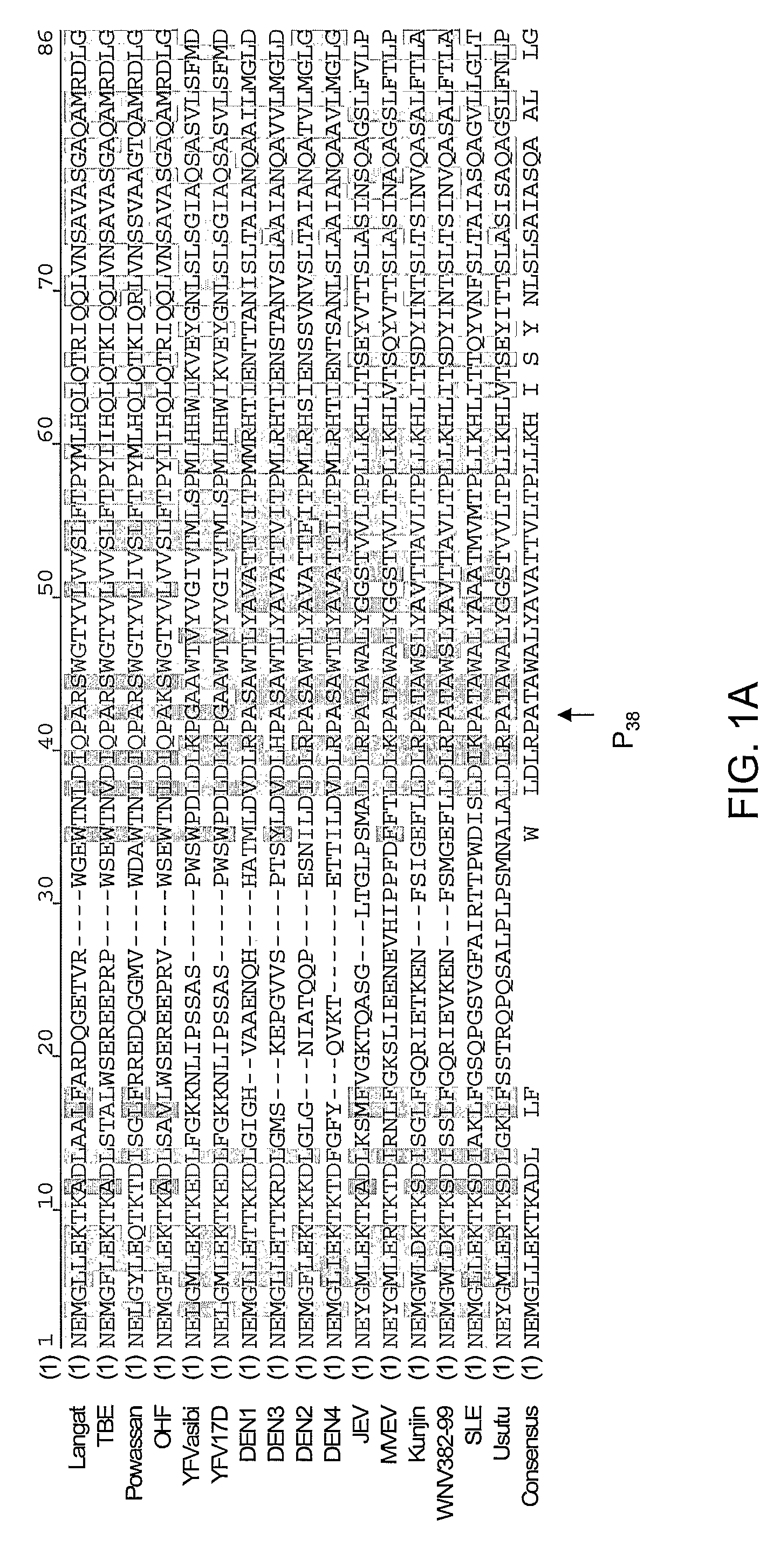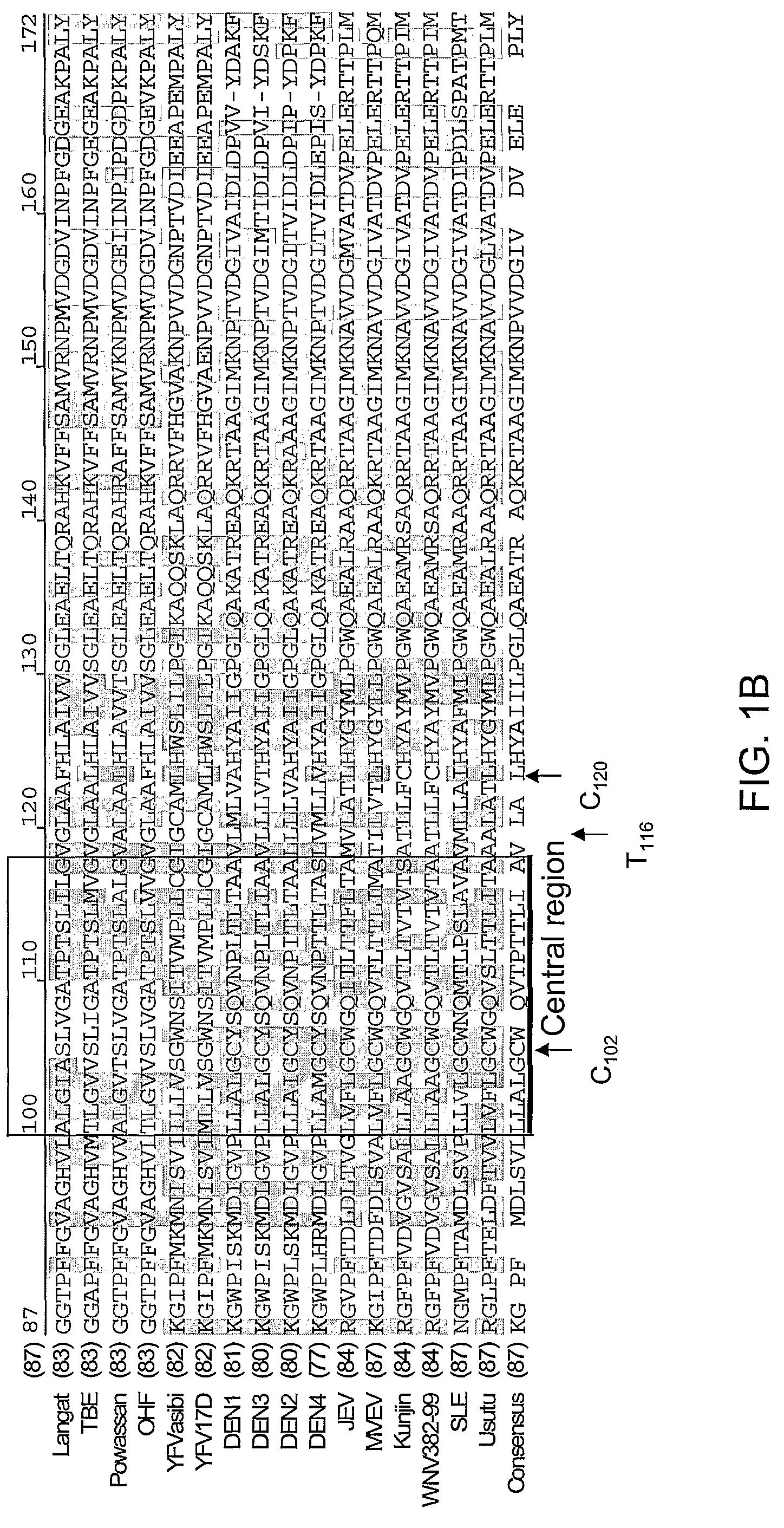Attenuated virus strains and uses thereof
a technology of attenuated virus and strains, applied in the field ofvirology, can solve the problems of reducing the rate of rna synthesis and delay in the production of infectious viruses, and achieve the effects of reducing glycosylation, high mutation rate of rna viruses, and reducing glycosylation
- Summary
- Abstract
- Description
- Claims
- Application Information
AI Technical Summary
Benefits of technology
Problems solved by technology
Method used
Image
Examples
example 1
Rescue of Mutant Viruses
[0128]The flavivirus NS4B protein secondary structure predictions suggest that it is a very hydrophobic protein with four transmembrane regions (see FIG. 1A-C). The protein has four cysteine residues at positions 102, 120, 227 and 237. Examination of amino acid alignments of flaviviral NS4B proteins reveals that C102 and C120 localize to a central region. While C102 is conserved throughout all members of the dengue and JE serogroups, C120 is unique to WNV and Kunjin viruses. Both C227 and C237 are located in the C-terminal region of the protein that is thought to reside in the ER-lumen. The C227 residue is conserved within the JE serogroup while C237 is again unique to WNV and Kunjin viruses. Since cysteines are often critical for proper protein function, the role of the four cysteine residues in the NS4B protein is investigated by mutating each of them to a serine using reverse genetics.
[0129]The 3′ plasmid of the WNV infectious clone WN / IC P991 serves as th...
example 2
Replication Kinetics of Mutant Viruses
[0132]Each recombinant mutant virus is investigated for temperature sensitivity by plaquing in Vero cells at both 37° C. and 41° C. Titers of recombinant viruses are determined by plaquing in Vero cells at both 37° C. and 41° C. Vero cells are allowed to grow to approximately 90% confluency in six-well plates. Media is removed, and cells are rinsed with PBS. Virus stocks are serially diluted, and 200 μL dilution is added to each well. Virus is allowed to incubate for 30 minutes before overlaying with a 50:50 mixture of 4% BGS 2xMEM and 2% agar. Two days after the first overlay, 2 mL of a mixture of 2% agar and 4% BGS 2xMEM supplemented with 2% neutral red was added to each well. Plaques are visualized and counted the following day and viral titers are calculated. Viruses found to be attenuated at 41° C. are plaqued at 39.5° C. to determine if this was a permissive temperature. Wild-type, and the C120S, C227S, and C237S mutant viruses all showed ...
example 3
In Vivo Virulence of Mutant Viruses
[0135]Recombinant viruses are diluted in PBS to obtain doses ranging from 103 pfu to 10−1 pfu. 100 μL of each virus dose is injected intraperitoneally into groups of five 3-4 week old female NIH Swiss mice (methods also described in Beasley et al., 2002). Clinical signs of infection are recorded for the following 14 days, and LD50 values are calculated for the various viruses. Three weeks following inoculation, surviving mice are challenged with a uniformly lethal dose (100 pfu) of wild-type NY-99 WNV to determine if mice had induced a protective immune response. If a virus is found to be attenuated via the IP route, it is administered by the intracerebral (IC) route to investigate the mouse neurovirulence phenotype.
[0136]The C120S, C227S, and C237S mutants are as virulent as wild-type WNV following intraperitoneal inoculation in terms of lethality and average survival time (Table 2). In contrast, the C102S mutant is attenuated when inoculated by t...
PUM
| Property | Measurement | Unit |
|---|---|---|
| permissive temperatures | aaaaa | aaaaa |
| temperatures | aaaaa | aaaaa |
| weight | aaaaa | aaaaa |
Abstract
Description
Claims
Application Information
 Login to View More
Login to View More - R&D
- Intellectual Property
- Life Sciences
- Materials
- Tech Scout
- Unparalleled Data Quality
- Higher Quality Content
- 60% Fewer Hallucinations
Browse by: Latest US Patents, China's latest patents, Technical Efficacy Thesaurus, Application Domain, Technology Topic, Popular Technical Reports.
© 2025 PatSnap. All rights reserved.Legal|Privacy policy|Modern Slavery Act Transparency Statement|Sitemap|About US| Contact US: help@patsnap.com



